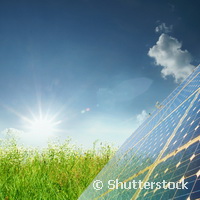Embedding solar cells more efficiently
Solar cells need to be tough to withstand snow, heatwaves, rain and humidity. This is why manufacturers often cover them in plastic, usually in ethylene vinyl acetate (EVA). The cells are encased in a plastic film which is then heated it up. Once the plastic is soft, the entire stack is pressed together in a laminator, so that the cells are properly encased. The advantage of this vulcanising, cross-linking process is that, once it is in this state, the material can no longer be melted. This protects the cells against mechanical and thermal stress. However, the time it takes to vulcanise the material can be rather long - the stack of cells must remain in the laminator for at least 20 minutes. This, of course, drives production costs up. This is why scientists from the Fraunhofer Center for Silicone Photovoltaics CSP in Halle have teamed up with chemicals company Lanxess, to find ways of embedding solar cells more efficiently. Together, they have managed to modify the lamination process so that it only takes about seven to eight minutes instead of 20 minutes. "We were therefore able to reduce the duration of the total process by more than 50 %," says Dr Stefan Schulze, polymer materials team leader at CSP. "In comparison to the standard process, we are therefore able to laminate twice as many modules on one system, which has direct positive effects on the production costs per module." The researchers were inspired by printing ink for newsprints which vulcanise in a few seconds after exposure to UV light. The cross-linker used by Lanxess worked in the same way. Activated by UV radiation rather than high temperatures, it cross-links the plastic within a few seconds while maintaining the same quality. The researchers at CSP developed the UV cross-linking process within the Fraunhofer Innovation Cluster SolarPlastics. They are now looking for answers to the following questions: How can the process be controlled? What temperatures are required? And how much radiation is required? The CSP already has a pilot plant for cross-linking, where scientists are currently optimising the four parameters: the amount of radiation, the temperature, the height of the lamp, and the feed rate at which the modules traverse under the UV lamps. "The process is operational," says Schulze. The team believes that interested manufacturers need not fear high costs for retrofitting their production facilities, as only one UV lamp would have to be added. This means that manufacturers have the opportunity to address cost pressures, while at the same time speeding up their operational processes.For more information, please visit: http://www.fraunhofer.de/en/press/research-news/2013/april/embedding-photovoltaic-modulesimore-quickly.html(opens in new window)
Countries
Germany



